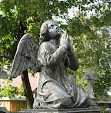 Image taken from Wikimedia.org: http://commons.wikimedia.org/wiki/Image:Kobold_artlibre_jnl.jpg
Image taken from Wikimedia.org: http://commons.wikimedia.org/wiki/Image:Kobold_artlibre_jnl.jpgI first encountered a reference to kobolds in Kinley MacGregor's Knight of Darkness this year. Before that I had never heard of them. According to Wikipedia.org, a kobold is a sprite of Germanic folklore, similar to brownies. They haunt households and can either do some excellent housework, or be mischievous, depending on their moods.
The Larousse Dictionary of Folklore says they are somewhat of habitual pranksters that love to hide things from the homeowner. Fortunately, they will also help the family member to find what is lost. They are easily offended, but will also sing the children to sleep a night. It is important to keep them well-fed to avoid them becoming discontented.
Wikipedia mentions that the element cobalt is named for these creatures, as a common variant dwells in underground caves and mines. This is derived from the fact that poisonous ores of this metal can often pollute other mined minerals.
There are individuals that specialize in plaguing certain types of people. For instance, Hoedeken hounds unfaithful wives, while Goldemar exposes secrets best kept hidden by clergymen.
According to Andrew Keightley's The World Guide to Gnomes, Fairies, Elves, and Other Little People, kobolds, the same beings as the English hobgoblins, haunt the houses of their chosen family as long as at least one member lives. The kobold will actually follow the family to their new dwelling if the family attempts to leave. The maidservants must take care to meet the Kobold's needs, and inform their successors to do the same.
In his book, Mr. Keightley recounts the story of a very famous kobold called Hinzelmann from an abridgement by MM Grimm. In this account, Hinzelmann is known to direct the housekeeping activities of the maids and to scold the housedwelling occupants on ethical and polite behavior. He protested to being exorcised, claiming he had nothing to do with the Devil.
The kobold appears quite frequently both in fiction and videogames. For examples, kobolds are found in the following works of fiction:
- Dragon Rider by Cornelia Funke
- The Spirit Ring by Lois McMaster Bujold
- Fablehaven: The Rise of the Evening Star by Brandon Mull features a kobold in a decidely sinister cast
- Revenge of the Shadow King by JS Lewis and Derek Benz has mercenary kobolds working for Morgan Le Fay
- The kobold Hinzelmann shows up as an benevolent protector of a small Wisconsin town in Neil Gaiman's American Gods
- Terry Brooks' Landover series features two different kobolds
- The Forgotten Realms series features kobolds as enemies throughout, nearly on par with goblins
References
Kobold. Wikipedia: The Free Encyclopedia. http://en.wikipedia.org/wiki/Kobold. Last modified 1 January 2008. Accessed on 2 January 2008.
Jones, Alison. Larousse Dictionary of World Folklore. 262. Published New York, New York: Larousse Kingfisher Chambers, Inc. 1995.
Keightley, Thomas. The World Guide to Gnomes, Fairies, Elves, and Other Little People. 239-258. Published New York, New York: Gramercy, 2000. Originally published as The Fairy Mythology in 1880.


